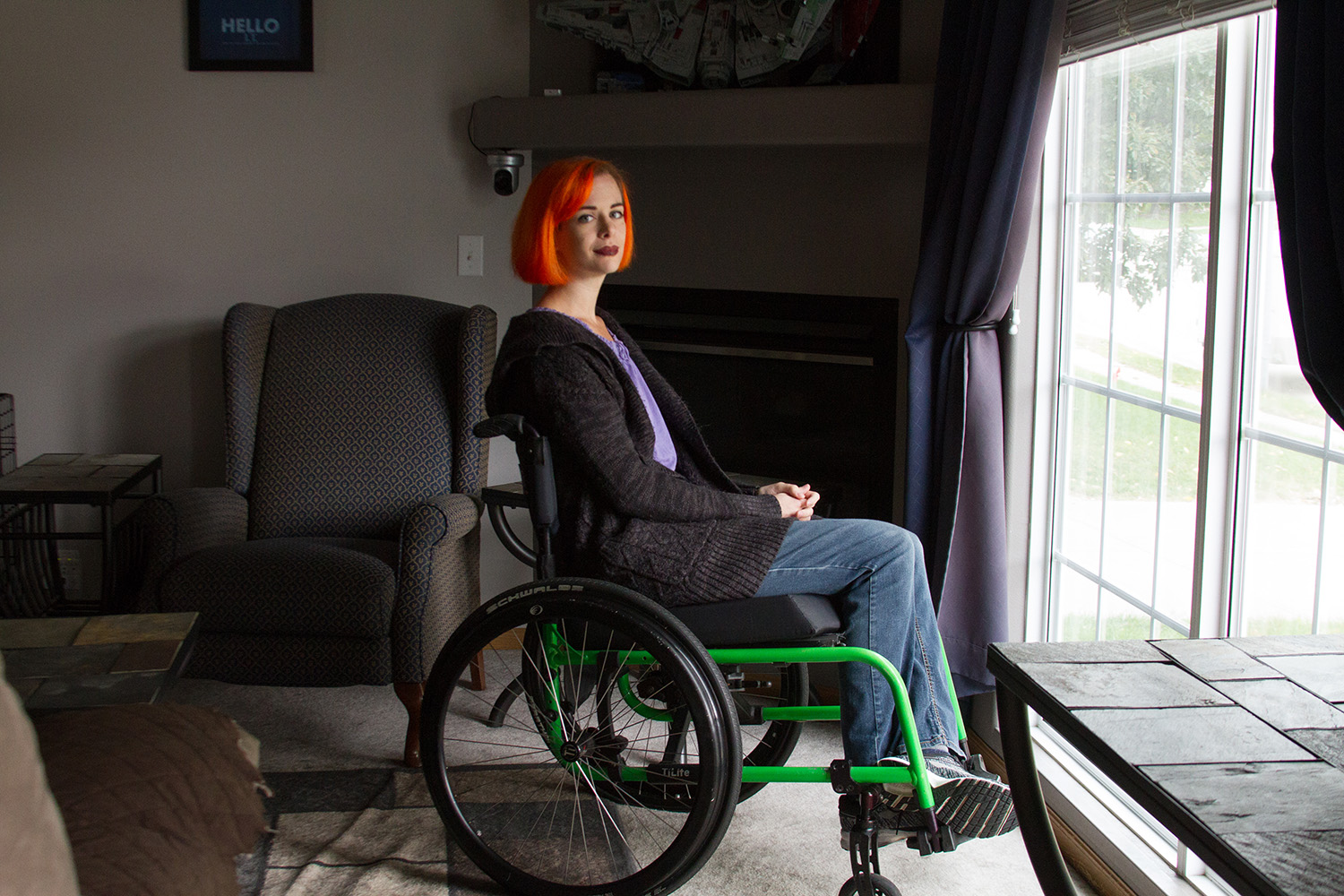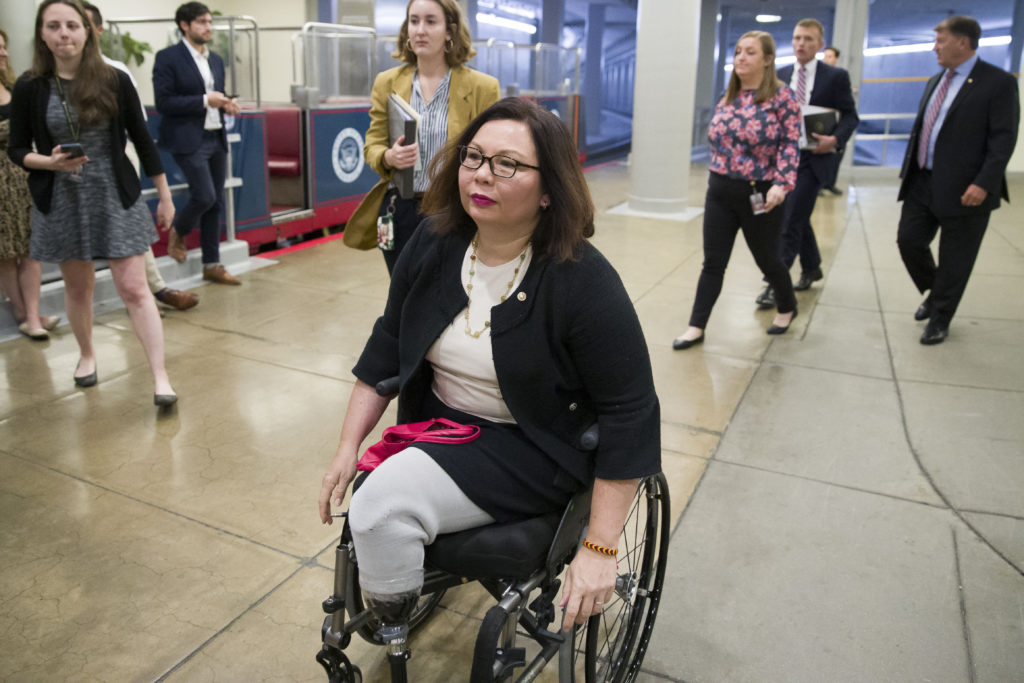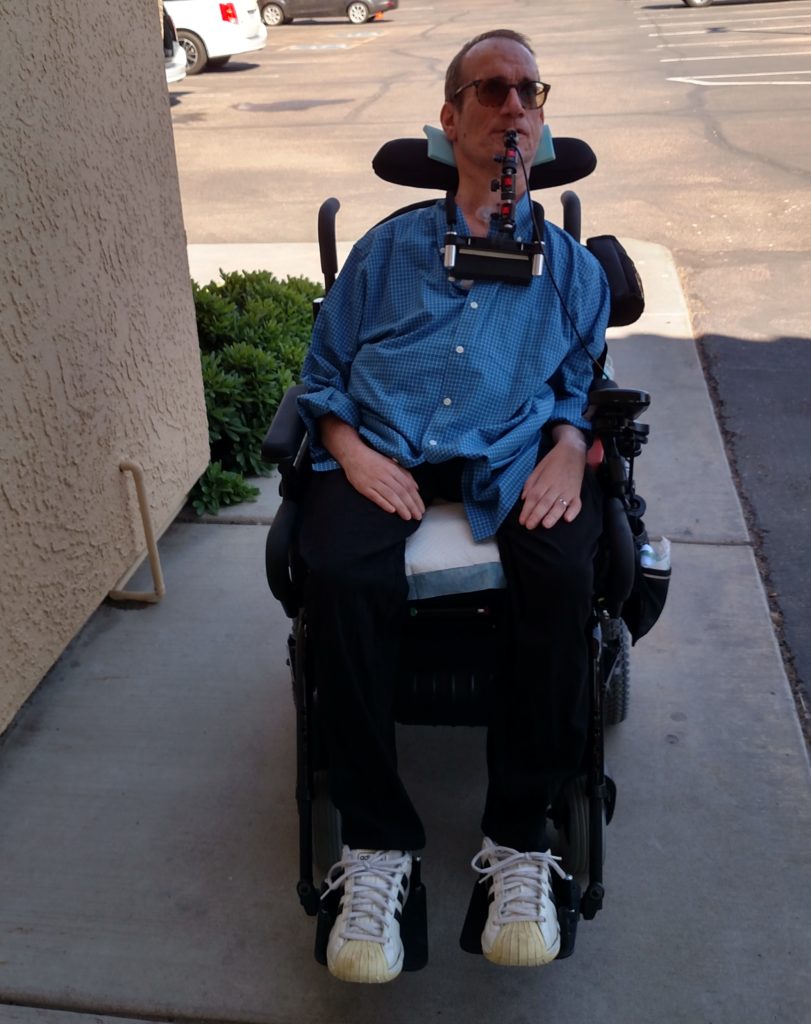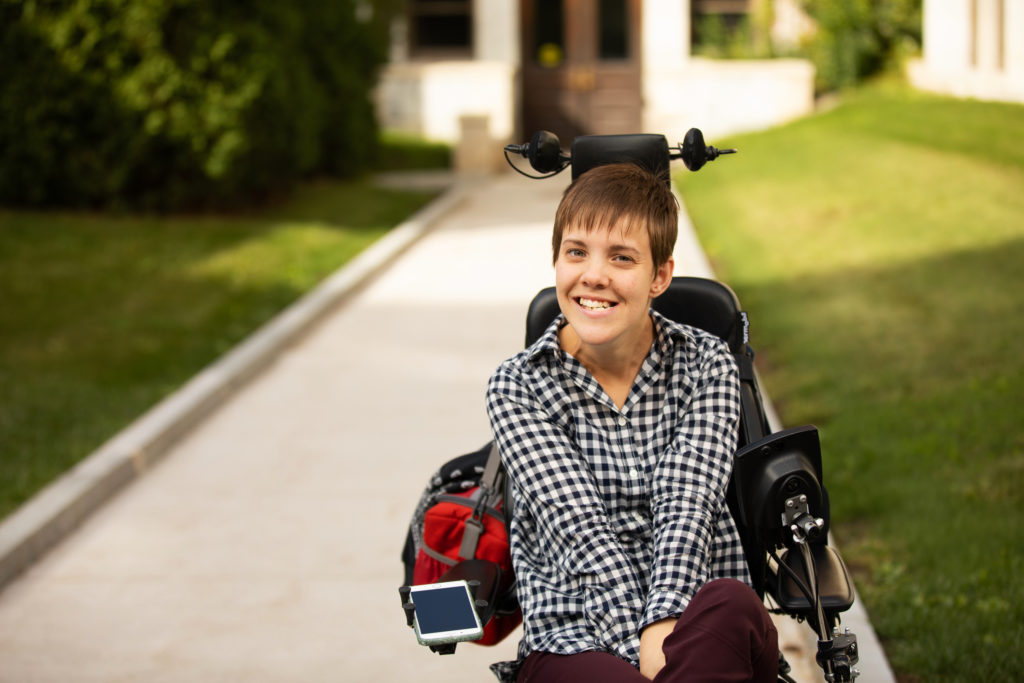Isabelle Briar, of Omaha, Neb., still uses a chair that was damaged during a United Airlines flight three years ago because she cannot afford the fix herself and she said the airline refused to do more than tape it. Katrina Bishop | Freelance Photographer
Wheels down
Airlines damage thousands of mobility aids every year. ‘It’d be an uproar’ if it were pets.
This story was originally posted Oct. 18, 2019
After a United Airlines flight three years ago, Isabelle Briar ripped open her thumb as she pushed her wheelchair away from the gate. The airline had cracked the metal grip ring, leaving a sharp, protruding shard.
The same airline ignored Cindy Otis’ complaint about damage to her power chair in 2006, responding weeks later and only after she had an attorney write a letter threatening to sue.
In 2017, U.S. Sen. Tammy Duckworth, D-Illinois, boarded a flight hours after writing federal Transportation Secretary Elaine Chao. Duckworth wanted to know why the agency again delayed requiring airlines to track damage to wheelchairs and scooters.
Sen. Tammy Duckworth, D-Ill., heads to the Senate for a vote on Capitol Hill on Sept. 24, 2019. The Army veteran lost both legs when the helicopter she was in was struck by a rocket-propelled grenade during a September 2004 mission near Baghdad. Alex Brandon | AP Photo
Upon landing, the Army veteran and amputee noticed her wheelchair no longer moved.
“They bent the metal bracket with the casters,” Duckworth said. “We’re talking about heavy-duty metal. I wonder, how are you managing to break these chairs?”
Not confident the U.S. Department of Transportation would implement the tracking rule it proposed years earlier, Duckworth slipped a provision into last year’s reauthorization of the Federal Aviation Administration to make it law.
It passed. Now, for the first time, major commercial airlines must tell the DOT each month how often they gate-check wheelchairs and scooters, as well as how often passengers report those devices as damaged, lost, delayed or stolen.
That requirement took effect in December, but some airlines reported challenges providing accurate figures that month.
Between January and August — the latest month for which data is available — U.S. carriers reported having mishandled at least 6,915 chairs. That’s an average of 29 times a day.
While it’s just 1.6% of the chairs and scooters checked on flights, more than a dozen travelers told GateHouse Media that damage to their mobility aids can have significant medical, emotional and financial consequences. Some avoid flying altogether, saying the risks are too great.
“They are essential mobility equipment. It’s important stuff,” said Ben Mattlin, a Los Angeles writer and power chair user. “God, if that many pets were injured every day, it’d be an uproar.”
Ben Mattlin at an Arizona hotel on road trip to Minneapolis to see his daughter graduate college. It would have been cheaper and quicker to fly, but he could not stomach the risk that his power chair might be damaged by airline crews. Ben Mattlin | Submitted photo
Duckworth said the general public fails to grasp the severity of the situation when a wheelchair is damaged or lost.
“These medical devices are essentially a part of a disabled person’s body,” Duckworth said. “Imagine if in a single year (that many) people had their legs broken by an airline as a result of flying. The effect is the same.”
United Airlines did not respond to multiple requests for comment.
Not an object
Travelers blamed a common misunderstanding for much of the damage: People see their chairs as objects rather than critical, customized extensions of their bodies that enable independence.
“We literally cannot function without them,” said Briar, a video game streamcaster from Nebraska who uses a manual chair.
It’s not just about being able to move.
Chairs also can provide features to support breathing, manage blood pressure and facilitate communication. They are custom-fitted to keep users secure and to minimize pressure sores leading to costly hospitalizations. Some people can walk short distances without an aid, but need chairs most of the time because of severe pain, bad balance, weak bones, injury-prone joints, nerve dysfunction or other chronic health conditions.
Because wheelchairs are not one-size-fits-all, they can take weeks to repair and sometimes cost thousands of dollars to replace a single part. Daily users require devices that routinely cost as much as a car, and the most specialized power chairs might cost as much as a small house.
If the damage from a flight isn’t immediately devastating, or if airlines refuse to pay for repairs, some people said they have lived with broken mobility aids.
Duct tape holds together a key metal beam of Briar’s wheelchair.
“Because of the nature of the way the chair fits, I didn’t realize my seat was missing half of its support until I transferred back into it in the (airport) bathroom,” she said. “Which was an uncomfortable and surprising moment.”
United Airlines nearly lost the metal rod in a plane’s cargo hold, she said, and refused to pay for repairs. Staff members used duct tape to hold the support rod in place instead, she said.
Noting the prohibitive cost to repair it and the days she’d be without her aid, Briar said, “I’m still using it in that condition.”
Passengers like Briar have taken to social media with their stories about damaged mobility aids using hashtags #FlyingWhileDisabled or #DisabledAirlineHorror.
They describe the nerve-wracking experience of watching baggage handlers drag and throw their chairs, or trying to force unfoldable chairs to fold. Some said chairs were returned to them with metal bars bent and melted, tires shredded, or with critical electronic components shattered.
Many also say they are frustrated that they must shoulder the burden of such incidents — formally reporting damaged devices and finding their own qualified professionals to make repairs — rather than airlines taking proactive steps to prevent such damage in the first place.
Undercount
The real number of mishandled wheelchairs is likely much higher than 29 per day, said advocates for people with disabilities.
That’s because many passengers don’t formally report damages to the airlines. Other times, the damage might not immediately be apparent.
Eric Howk, a guitarist for popular rock group “Portugal. The Man” flies more than 100 times a year, crisscrossing the country each weekend for concerts.
Even though his manual wheelchair is often damaged and delayed while flying, Howk said he never has filed a federal complaint or requested a Complaint Resolution Officer — staff members trained to resolve disability-related issues.
Usually, he doesn’t even report the issue to the gate agent. He notes he is lucky to have the physical ability and financial means to fix most damage himself, saying he’s a tinkerer.
Eric Howk of Portugal. The Man performs at the Coachella Music & Arts Festival at the Empire Polo Club on Sunday, April 15, 2018, in Indio, Calif. Amy Harris | Invision/AP
That said, he currently sits in a replacement chair provided by Alaska Airlines, which reports mishandling fewer than 1% of mobility aids.
“I watched a ground crew member snap the back off the chair,” he said.
Alaska Airlines said in an email that it’s “always committed to improving where we can – especially in this area.”
It’s not just damaged equipment that plagues travelers. One weekend in September, Howk’s chair was lost twice. Each time, he had to wait hours for crews to find it.
In June, he said he was escorted off a Delta flight in Atlanta and left in a hot, outdoor jetway for an hour, still strapped into a narrow aisle chair with his arms restrained, while crews searched for his wheelchair.
Delta ranked second best, reporting 0.8% of chairs they enplaned were damaged in the eight-month period. Spokeswoman Olivia Mays said the company has an advisory board on disability and a “dedicated wheelchair damage-reduction working group.”
“We know it’s a problem,” she said. “Damaging one wheelchair is not OK.”
Kristen Parisi, a New York freelance writer, said JetBlue lost her chair when she traveled to a bridal shower this summer. It happens so frequently that people just endure it rather than report it, Parisi said, just like they do with other daily challenges.
“It just becomes part of your normal. It’s weird because it shouldn’t be,” she said. “I’m not saying you shouldn’t file. It’s just that if I filed something every time I was discriminated against, that would be a lot of times.”
JetBlue was among nearly a half-dozen airlines that did not respond to multiple messages seeking comment on the new federal regulations and what, if any, changes they’ve made to their procedures, along with questions about their existing training and policies. The others were Spirit, Hawaiian, United and Allegiant.
Among airlines required to submit information under the new tracking rule, an average of 1.6% of chairs and scooters were reported as damaged. In the first eight months of this year, American Airlines had the worst record, mishandling 1,846 devices — or 3.7% of all the mobility aids it gate checked.
“We are working hard to build tools and training so that every wheelchair is returned to the passenger in great condition,” an American Airlines spokesperson wrote in an email. “This data and other information are being used to develop a comprehensive plan for improving the customer experience for the long term.”
(Read airlines’ full responses here.)
Help us report more stories
about the Air Carrier Access Act.
Fill out this short form to share your story of flying with a mobility aid or to tell us what you think should be the focus of future reporting: http://bit.ly/ChairTraveler.
Contact Reporter Jayme Fraser: 941-361-4923 or jfraser@gatehousemedia.com.
Hope for change
Duckworth hopes the new requirement will help federal regulators better monitor the issue and identify ways for airlines to improve, as well as empower travelers to make informed buying decisions.
“Ultimately,” she said, “it’s about treating medical devices with respect.”
GateHouse Media asked the USDOT how it plans to use the new data, what rate of mishandling it deems acceptable, and whether it plans to issue airlines new guidelines to reduce damage.
An agency spokesperson responded by email that USDOT publishes the data in its monthly Air Travel Consumer Report but did not mention any other plans.
Presidential candidate Beto O’Rourke, a former Texas congressman, announced in a blog post Tuesday that he would strengthen enforcement of the Air Carrier Access Act, among other policies, if elected.
Chair users have their own common-sense solutions they say airlines should adopt, such as adding a special section in cargo holds to safely secure mobility aids away from other luggage. Others said airlines should store folding manual chairs in the cabin rather than the cargo hold — something already required, but rarely followed, under federal rules.
And airlines should streamline the damage complaint process, some said, to minimize paperwork and ensure quick repairs.
Jennifer Brooks, a doctoral student at Syracuse University, said she left her power chair at home and took an inadequate transport chair when she flew to Georgia to see her dying father. Cherilyn Beckles | Freelance photographer
The most popular solution: Let passengers keep their chairs and sit in them during flights.
“They don’t demand anyone else to put their legs in cargo, but they do when your legs are wheels,” said Jennifer Brooks, a power chair user from Syracuse, New York.
The United States Access Board is testing the safety of people flying with their chairs strapped to the floor, similar to how they travel on city buses. Duckworth’s additions to the FAA reauthorization bill included a requirement for that study, which is expected to be sent to Congress in October 2021.
If he could fly in his own chair, Mattlin said, he would be able to travel without fear of losing his health or independence. The West Coast writer said he’d return to Europe to revisit places he saw as a teen and go to New York to reunite with friends and family.
“There is so much support for this,” he said. “It seems possible for me. Maybe not every plane. Maybe just a few at first, but I hope to see it.”
Cindy Otis, a cyber-security expert, says her power chair is damaged during flights, including this month when her joystick control was smashed. Here she is seen in Turkey. Cindy Otis | Submitted photo
But other wheelchair users said they are exhausted and skeptical.
“People generally don’t make an effort, especially big institutions, to take disability into account unless they are forced to,” said Brooks, a doctoral student who researches labor market disadvantages for people with disabilities. “It’s just too much time, effort and money.”
Otis, who had the joystick of her power chair smashed during an October flight for work, said the new tracking requirement is important for accountability, but not enough on its own.
“There have to be consequences,” said the East Coast cybersecurity expert. “They’ve had anecdotal data for years at this point. … We know what the data says already. We know what’s happening. There needs to be some enforcement.”
UPDATE: An earlier version of this story misidentified Duckworth’s mobility impairment and has been corrected.





